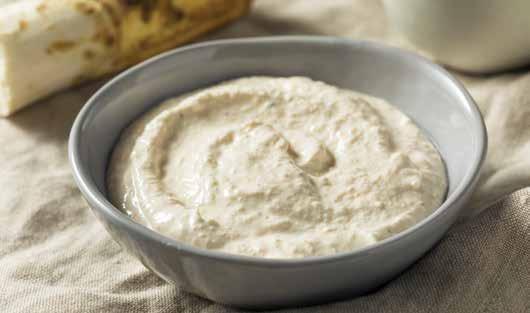
2 minute read
Fresh Take: Horseradish
Fresh Take
HORSERADISH
By Dylan Roche
Congested? You might just need to eat something with a bit of kick to clear your airways. If you want something that provides that reliable burst of heat but without the burning aftertaste you often get with peppers, look no further than the winter vegetable horseradish.
Part of the Brassicaceae family along with Brussels sprouts, rutabaga, cabbage, and turnips, horseradish comes out of the ground in the form of a large off-white root. When it’s intact, it doesn’t have much of an aroma to it. But as soon as you cut into it and start chopping it up, it releases a type of oil known as allyl isothiocyanate that’s the source of its pungent odor and flavor.
In fact, as far back as ancient cultures, including the Egyptians and Greeks, horseradish was used as an early form of an expectorant. It became a culinary mainstay in Eastern and Central Europe before spreading across the continent to eventually reach England in the 17th century. The English were the first to use horseradish as it is traditionally used today: shredded, seasoned, and served alongside beef and oysters for a bit of strong flavor. Settlers later brought horseradish to the Americas, and today, the U.S. population enjoys nearly six million gallons of prepared horseradish every year.
Most people don’t eat horseradish in large amounts—it’s most often served as condiment because of its strong taste. A larger serving would be way too intense! In fact, some Japanese restaurants serve horseradish disguised with a bit of green food coloring in place of wasabi. But even in small amounts, horseradish provides several important vitamins and minerals, including potassium, magnesium, zinc, and vitamin C.
The true health benefit of horseradish, however, lies in its potentially antibacterial and anticancer benefits. It’s rich in compounds called glucosinolates, which can inhibit the growth of
Classic Horseradish Sauce

INGREDIENTS:
1 cup sour cream 1/3 cup pulsed horseradish root 1/3 cup white vinegar 1/3 cup water 1 tablespoon course sea salt 1 tablespoon sugar 1 teaspoon apple cider vinegar 1 tablespoon chopped chives Salt and pepper to taste
DIRECTIONS:
Begin by combining the white vinegar, water, sea salt, sugar, and horseradish in an airtight container and allowing it to soak overnight. Drain the prepared horseradish and combine it with the remaining ingredients. Serve with steak, prime rib, beef tenderloin, or deviled eggs.
cancer cells, and the allyl isothiocyanate oil that gives it such a strong taste can help fight bacteria like E. coli and salmonella.
And don’t think that its potential for relieving colds and other respiratory problems is all folk medicine and superstition—studies have actually shown that horseradish can be just as effective as antibiotics in healing sinus infections.










